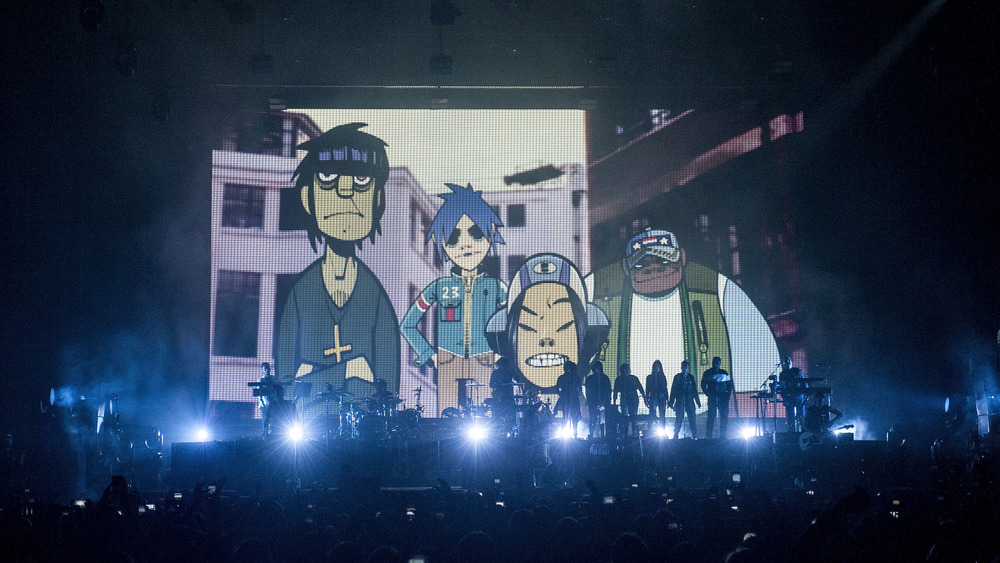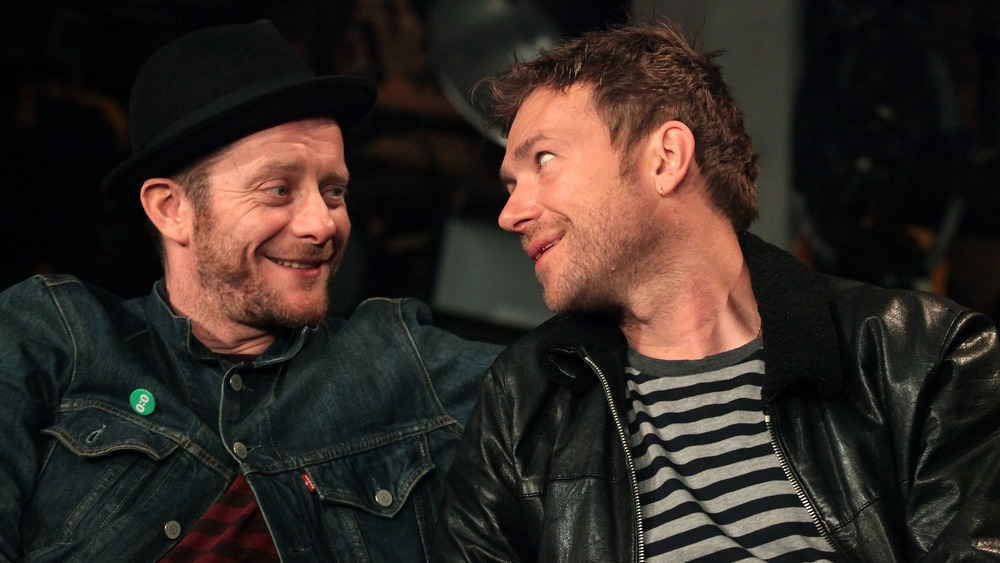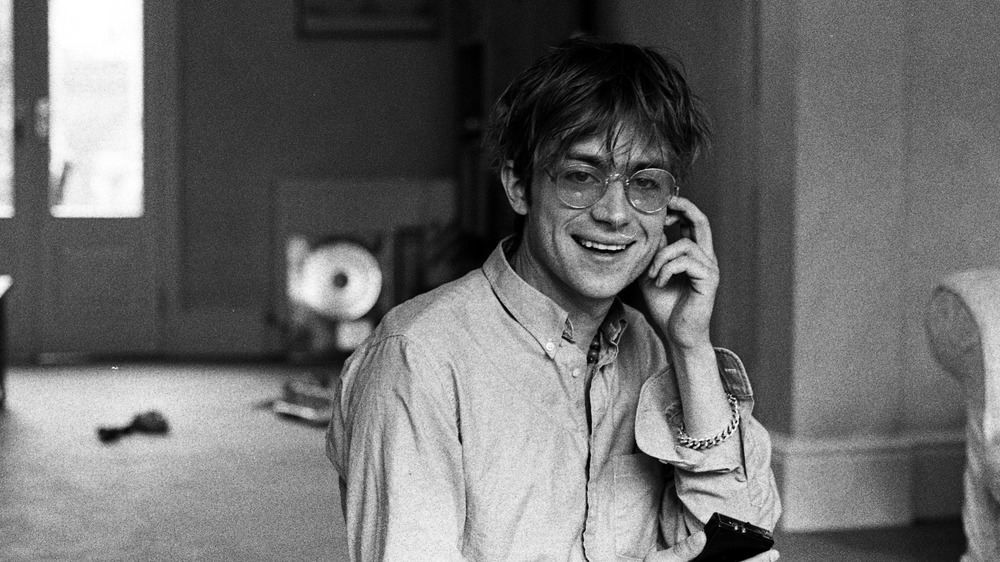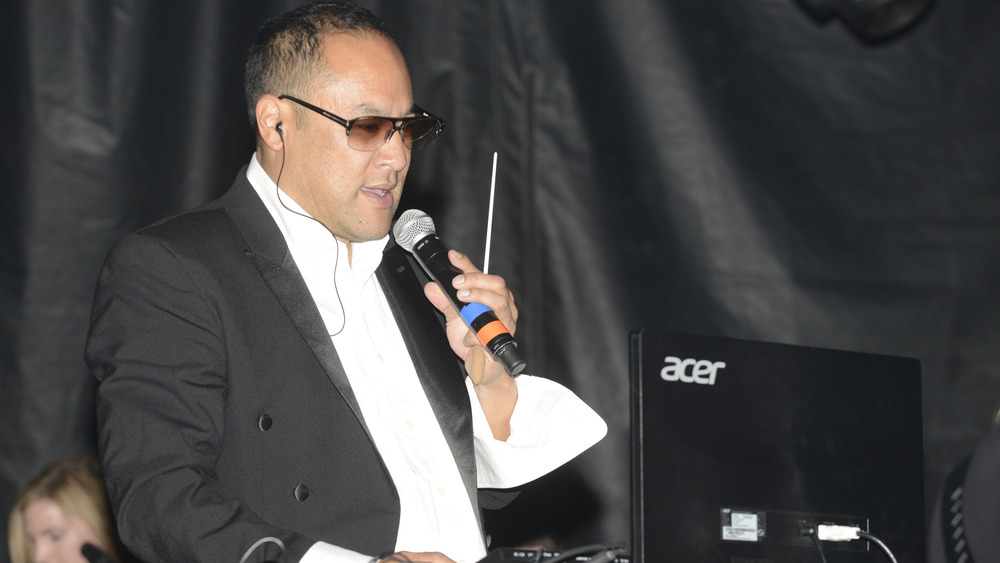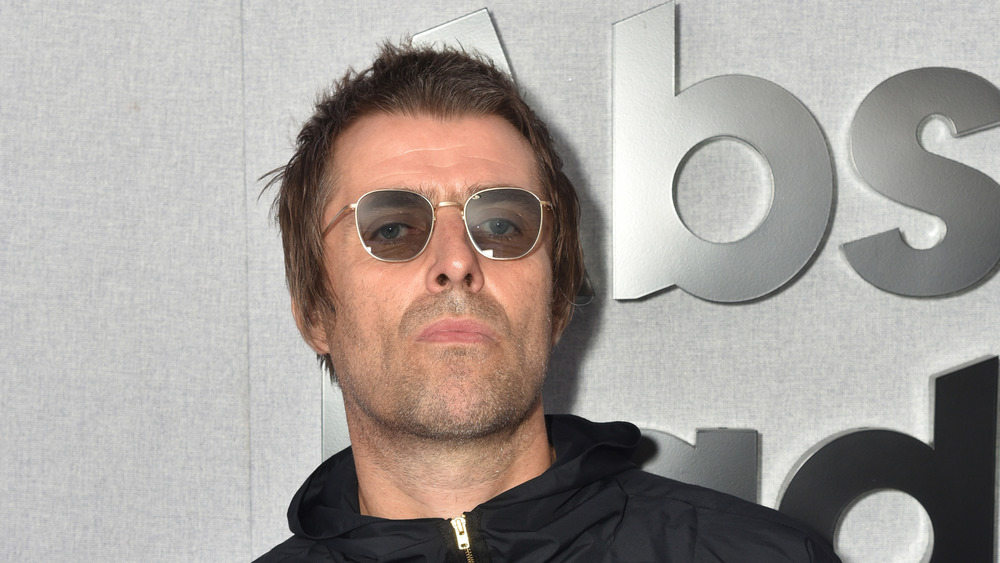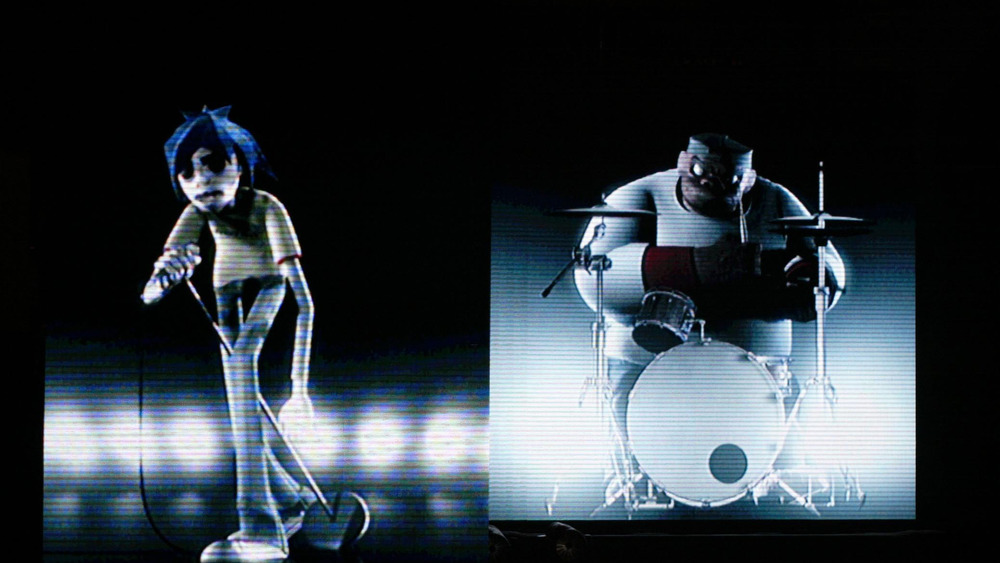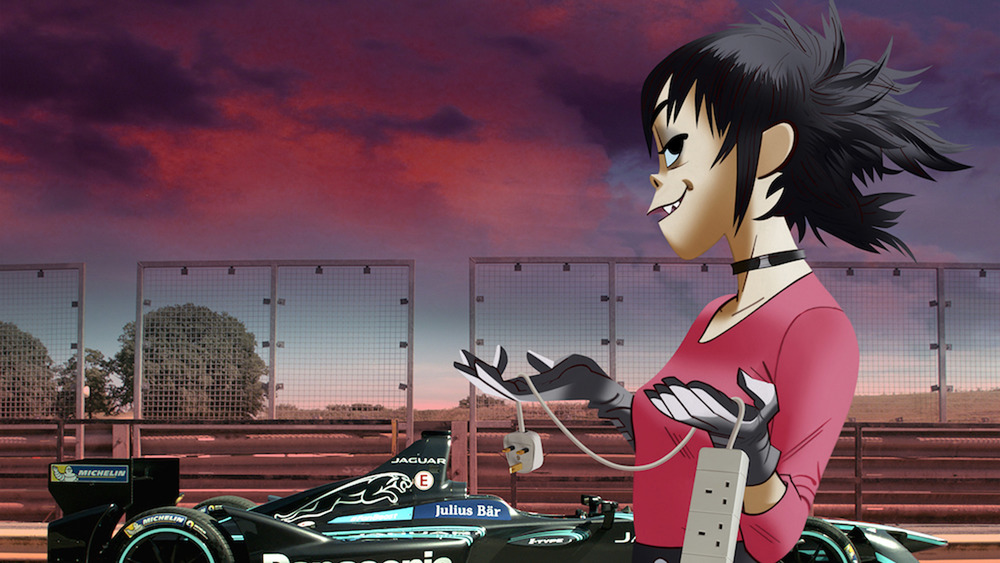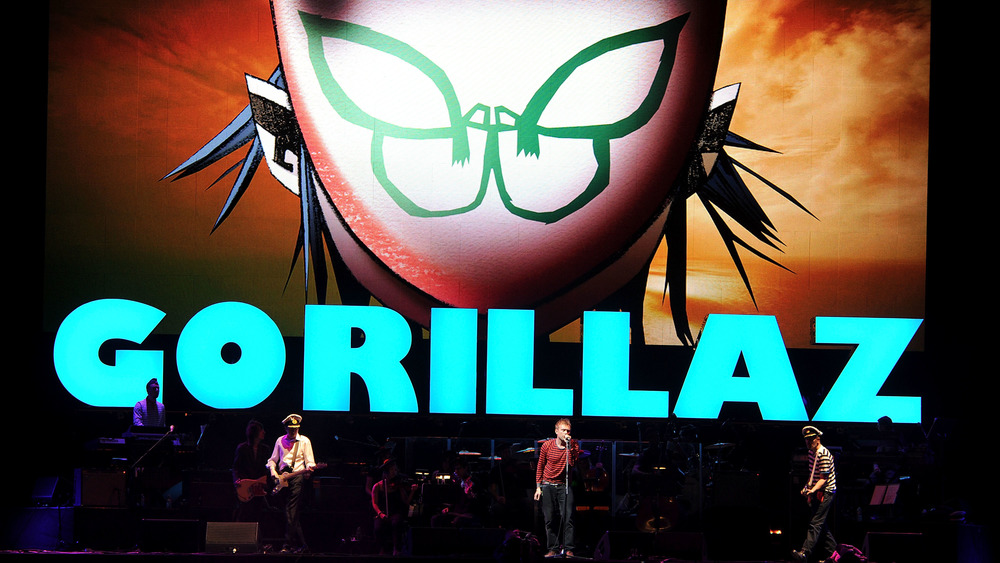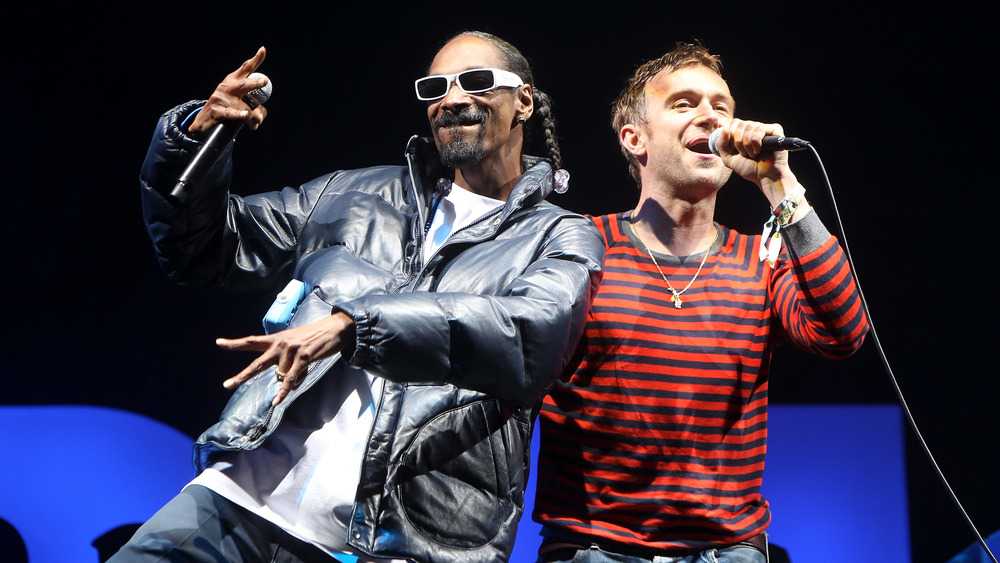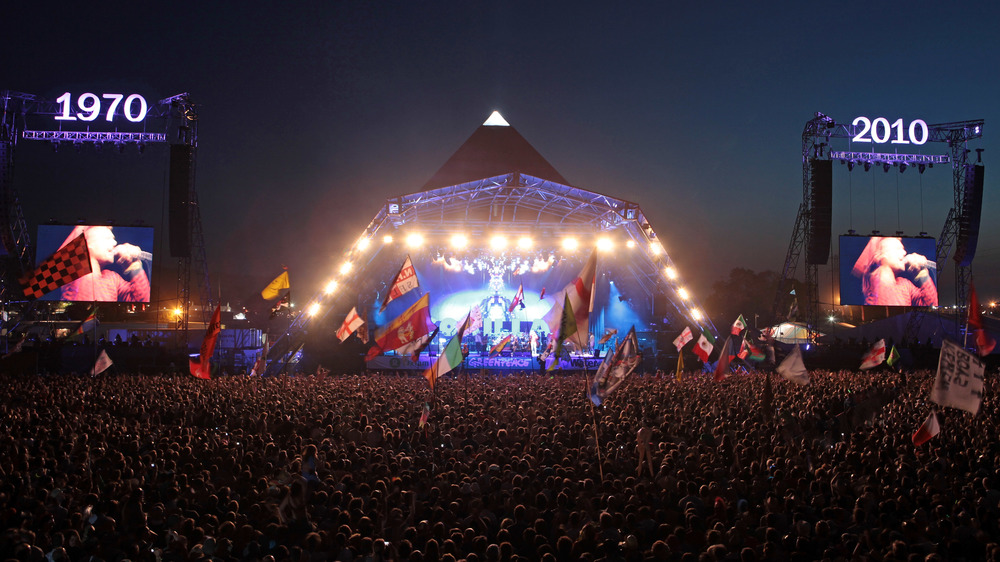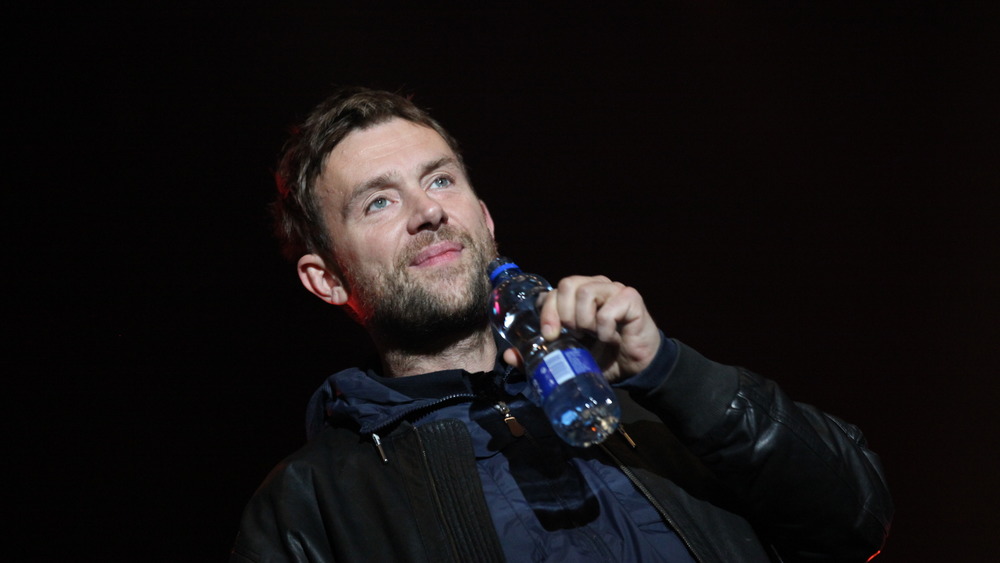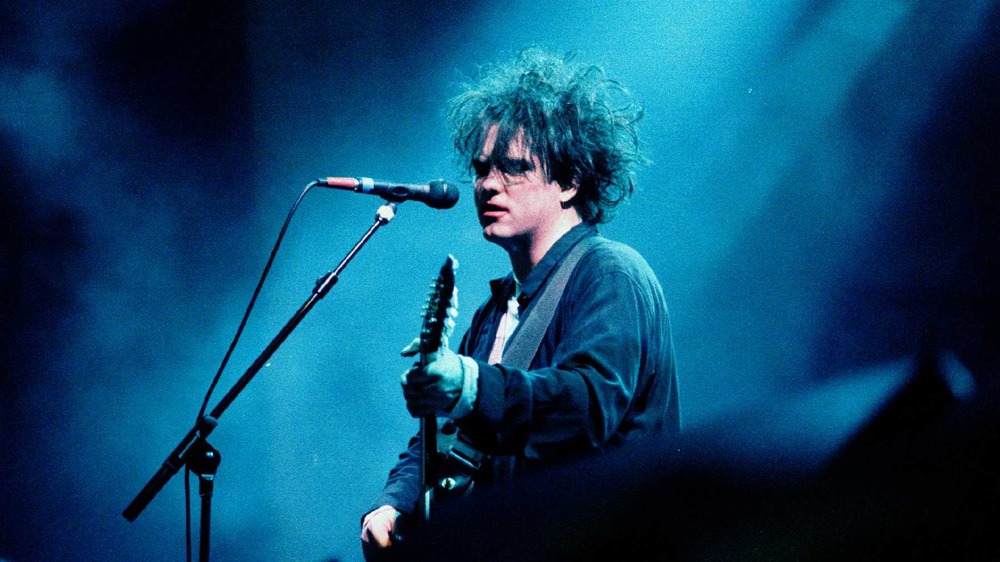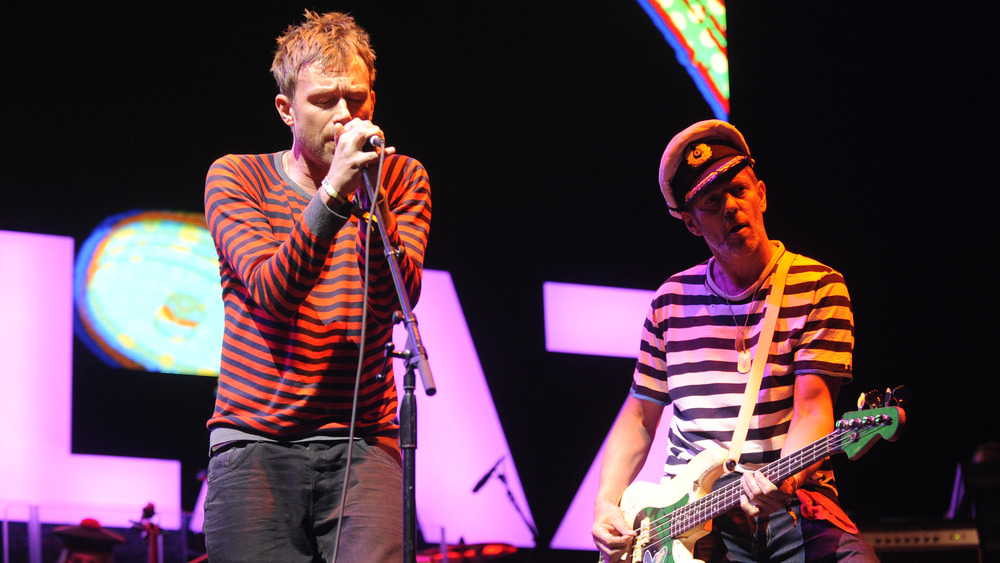The Untold Truth Of Gorillaz
Everyone's got a favorite Gorillaz song. For some purists, it's the early work, such as the group's breakout single "Clint Eastwood," featuring Del the Funky Homosapien. For others, it's one of the gorgeous pop tunes that principal songwriter Damon Albarn came up with during the group's middle period, such as the simplistic "On Melancholy Hill." But the truth is that Gorillaz has never just been about the songs.
Since its inception in 1998, the virtual band made up of Stuart "2-D" Pot, Murdoc Niccals, Russel Hobbs, and Noodle — though created by real-life humans Albarn of Blur fame and Tank Girl creator Jamie Hewlett and now including producer/percussionist Remi Kabaka Jr. — has been about showing the music industry how to do things differently. Even now, the highly collaborative group — which Albarn has characterized as being more like an "organization" than a traditional band — are coming up with new blends of popular genres and innovative ways to get music out to their millions of fans. You could even argue that, with Gorillaz, it's only really half about the music in the first place. But it's not all been easy, and many fans have previously had to come to terms with the fact that "Gorillaz are over," as was once reported by Rolling Stone.
Here's their story.
The creators of Gorillaz didn't like each other
Most bands are made up of old friends who know each other and become thick as thieves as they practice to master a sound of their own. As ever, though, Gorillaz was different. Originally, the two brains behind the virtual band didn't even like each other.
Damon Albarn was already a big name in music back in the late 90s. His band, Blur, were a Britpop phenomenon, with a string of hits including "Parklife" and "Song 2" and a series of albums that had topped the British charts. Meanwhile, Jamie Hewlett was a celebrated cult artist, whose Tank Girl comic strip had a devoting following. It was while working for Deadline magazine that Hewlett first came into contact with Albarn, after being commissioned to interview Blur back in 1990.
However, as Hewlett later told Q magazine, the interview was a disaster. Certain members of the band were drunk, and Albarn gave off a confrontational vibe. "He was arsey, a wanker," Hewlett recalled. The situation was further complicated when Hewlett began a relationship with the ex-girlfriend of Graham Coxon, Blur's guitarist. While the other members of Blur began to turn against Hewlett, the pop artist found his friendship with Albarn growing, until the two eventually ended up as flatmates in the trendy Notting Hill area of London.
Gorillaz was "manufactured" in a party flat
Both Damon Albarn and Jamie Hewlett found themselves newly single in 1998. Albarn's long-term relationship with Elastica's Justine Frischmann had recently fizzled out, while Hewlett had also broken up with Coxon's ex, also of Elastica, Jane Oliver. So the two did what you do when you're young, rich, successful, and living in "Cool Britannia" London — they started partying.
"We'd go out and come back with 40 people," Albarn told Q back in 2001. It was such a regular occurrence that the flatmates' fellow celebrities wanted to get in on the scene, with members of the Spice Girls mixing with musicians from both indie bands Radiohead and Pavement. According to Hewlett, even David Bowie was getting in touch to hunt down an invite.
It was during one of the friends' hungover sessions binge-watching television that the idea for Gorillaz first arose. "We were home watching MTV with our eyes just kind of glazed. Because if you watch MTV for too long, it's a bit like hell — there's nothing of substance there," Hewlett told Wired. "So we got this idea for a cartoon band, something that would be a comment on that."
At the time, the United Kingdom was in the middle of a trend for "manufactured" bands, with boybands such as Westlife and Take That dominating the charts. Gorillaz was conceived as a reaction to this — a band for which even the members themselves were manufactured.
Gorillaz owes its sound to Dan the Automator
The idea for Gorillaz came about at a time when both of its principal creators had become restless. Jamie Hewlett had been working on Tank Girl for many years and was reportedly growing "bored" of his project, while Damon Albarn was already looking around for outlets through which to channel his many disparate musical influences that, for one reason or another, wouldn't marry with the style of Blur. Albarn had recently contributed to the debut album by hip-hop supergroup Deltron 3030, a "rap opera" set in the distant future featuring rapper Del the Funky Homosapien, producer Dan the Automator, and DJ Kid Koala.
The grand themes and the genre-bending sound of Deltron 3030 surely had a huge influence on Albarn, who around the same time was working on Gorillaz's debut EP and album. Albarn had already composed much of the music for what would be 2001's Gorillaz LP and invited the Automator — whom the Blur singer had first met at a Chelsea football match, according to the Guardian – to help finish off the record. The super producer whose real name is Dan Nakamura may be responsible for Gorillaz's now-famous collaborative methods. "I brought in different people to be on the record," he told MTV, while his experience in hip-hop and sampling gave Gorillaz a vastly different sound to the music Albarn had created with Blur.
Albarn wanted Liam Gallagher to work with Gorillaz
The peak of Damon Albarn's fame in the 90s had been during the notorious "Battle of Britpop" in 1995, when the British press created a frenzied rivalry between Blur and Oasis, whose singles "Country House" and "Roll With It" were released on the same day. The event caused a famous war of words between the two bands, who taunted each other mercilessly in interviews and public appearances.
Half a decade later, however, Albarn would make some unexpected comments to the press that would suggest the feud was dying down.
"Liam [Gallagher]'s a ... brilliant singer," Albarn told Q. "I really mean it. I don't think he's had any particularly strong songs to sing for years, and that's someone who thrives on a great melody." But Albarn seemed to understand that chances of collaboration at the time would appear remote. "I just don't know whether he'd be able to do that. If they could deal with that. I'm not trying to cause problems."
However, a Gallagher would eventually become involved in a Gorillaz project almost two decades later, when Noel, not Liam, agreed to collaborate on "We Got The Power," the closer to 2017's Humanz.
Gorillaz find their feet
Gorillaz immediately caught the attention of the British music press, while "Clint Eastwood" — named thusly because the single features extracts from the theme music to The Good, The Bad, The Ugly — became a huge hit and effectively introduced the Gorillaz to a popular audience. The group's debut album was released to positive reviews and was nominated for the prestigious Mercury Music Prize, before being withdrawn at the band's own request. The nomination was "like carrying a dead albatross round your neck for eternity," said a statement from fictional bassist Murdoc, according to the BBC. Meanwhile, fans of the band were making the most of the immersive Gorillaz experience, enjoying a huge amount of extra material on deluxe editions of the album and on the Gorillaz website, which was particularly cutting edge for a band at the turn of the century.
But while Gorillaz was making a success of the musical, marketing, and multimedia possibilities of being a virtual band, live performance still proved to be something of a challenge. Early concerts were conducted with the entire live band, including Albarn, obscured behind an animation screen, which Albarn claimed in an interview with Hot 97 he found difficult. Eventually, Gorillaz would drop such self-imposed limitations and allow the audience to see the live performers.
The long gestation of the Gorillaz feature film
The four animated characters that make up the fictional members of Gorillaz captured the imaginations of fans of all ages instantly. And with the band's debut selling an impressive 300,000 copies in the United States in the first weeks of its release (it eventually went platinum, selling 1.9 million copies there and 7 million around the world), it wasn't long before long Hollywood came knocking. The Guardian reported back in 2001 that the virtual group had already had some interest from Steven Spielberg and that he had even been spotted visiting Damon Albarn's Studio 13. As sources at the time speculated, the project promised to be huge, with great potential for everything from cutting-edge animation to a hit soundtrack to lucrative merchandising.
However, the project failed to materialize. Jamie Hewlett had previously had a bad experience in the world of movie-making when the adaptation of his Tank Girl comic series became a critical and commercial failure, likely contributing to the decision not to pursue a feature-length vehicle for his new, hugely popular characters.
However, good news has eventually emerged for fans of the band, as in October 2020, Albarn finally confirmed that a Gorillaz movie is in the works. "We signed contracts, we've begun scripts and stuff," he said according to Spin, adding that it's "an animated film that's kind of abstract"
Gorillaz has a narrative
But just because we've had to wait 20 years for a Gorillaz feature-length animation, that doesn't mean that Gorillaz hasn't been telling a story. In fact, every aspect of Gorillaz animation, from the album sleeves to the music videos to the band's website, has come to add an immersive and sprawling "Gorillaz lore." Details go all the way back to how the animated four-piece supposedly met after Murdoc drives over 2-D's head in a bungled ram-raid attempt, Russel, who is possessed by ghosts, arrived from New York, and Noodle turns up in a shipping container with nothing but a guitar.
This is the first phase of the Gorillaz story, according to Dazed, which becomes even more "complicated and fantastical" as time goes on, starting with a dark twist — that Noodle had originally been brainwashed as a child to become a human war machine. The story of each phase is soundtracked by the music, with the band's second album, Demon Days, released in 2005, reflecting the dark themes of the band's story. Demon Days improved on the formula of the band's debut, with a greater range of collaborators and an even greater assortment of multimedia with which to tell the story of the virtual band. The album went to the top of the charts in the U.K., and number six in the U.S., thanks in part to the huge hit single "Feel Good Inc.," featuring De La Soul.
Gorillaz's environmentally themed smash
The five-year gap between the first and second Gorillaz albums proved to be something of a habit. Though the group followed up both with albums comprised of B-sides, alternate versions, and demos, Gorillaz fans would have to wait until 2010 for another full-length collection of strictly new material. But it was worth the wait.
Plastic Beach dropped in March after a lengthy promo period, in which the band's website was updated with a new theme, and animated snippets began to be circulated, teasing aspects of the phase three story, with snatches of new music. The list of featured artists alone was impressive. Bobby Womack, Snoop Dogg, Lou Reed, Mick Jones, Little Dragon, Mos Def, Paul Simonon from The Clash, and scores of other great artists contributed to what, upon release, Rolling Stone described as "Gorillaz's third excellent album in a row," according to Reuters.
Not only did Gorillaz once again draw together an eclectic musical ensemble with an immersive visual world, but the project was permeated with the theme of environmentalism. So much so that critics agreed that Gorillaz — a concept themselves — had created a hugely successful concept album. From adrenaline-pumping lead single "Stylo" to down-tempo fan favorite "On Melancholy Hill," it seemed like Gorillaz had given fans a whole world to explore. "It is probably Gorillaz's most engrossing project so far," wrote Kitty Empire in the Guardian. The album was followed by a successful tour and another album, The Fall, released in December.
Gorillz fell apart in 2011
Plastic Beach cemented Gorillaz as one of the most innovative pop music projects on the British music scene, and the phase peaked with a headline slot at England's Glastonbury festival in 2010. Looking back, the concert showed how far the group had come from their early live performances, with a huge ensemble cast of performers joining Damon Albarn and his musicians on stage. But reviews of the gig were mixed, with many such as the Guardian claiming that the band was too experimental for the main stage, though many fans have since looked back on it as a classic performance.
However, one aspect of the show was a precursor to what was to come — a distinct lack of animation, with a smaller screen in use above the stage than the group had used in their earlier shows. "Damon had half the Clash on stage, and Bobby Womack and Mos Def and De La Soul, and ... Hypnotic Brass Ensemble and Bashy and everyone else. It was the greatest band ever," Jamie Hewlett told the Guardian. "And the screen on stage behind them seemed to get smaller every day." Around the same time, Gorillaz's label EMI cut the budget for a series of high-end animations Hewlett had been commissioned for. The partnership was becoming distinctly uneven. Albarn and Hewlett fell out, and the two friends and collaborators didn't speak to each other for three years.
Did Gorillaz predict the Trump administration?
Following the fallout from their argument — the details of which still haven't really be spoken about in public — Damon Albarn and Jamie Hewlett took a long hiatus from Gorillaz. Albarn was especially productive, working on a number of different collaborations, as well as his own debut solo record, Everyday Robots, released in 2014. Hewlett continued to make art and paint prolifically, according to the Guardian. The friends reconciled at a Christmas party at the end of 2014, but, as Albarn was also in the middle of reigniting his relationship with Blur for the release of a new album, Gorillaz was still on the back burner.
Work on the next Gorillaz album, Humanz, started in 2015 and 2016, with sessions for the album taking place in London, Paris, New York, and Port Antonio in Jamaica, again revealing the range of influences and collaborators that the group had envisioned for the project. The album was eventually released in 2017 and proved to be another hit.
One eyebrow-raising detail emerged during the album's promotion, when Pusha T, who appears on Humanz, claimed that Albarn had predicted Donald Trump's ascent to the White House, and that Humanz was planned as a "party for the end of the world" based on Albarn's foresight. "I always had a slightly witchy element to my psyche. The role of magic is not to be underestimated," Albarn later said.
The Song Machine keeps turning
Humanz represented the return of Gorillaz as a big concept, innovative collective, and was supported by the hugely ambitious "Demon Dayz" festival in Margate, England, as well as an extensive world tour. Demonstrating the group's productivity after their reunion, the album was followed by an extended "deluxe" version with an incredible 14 new tracks. And just a year after Humanz came another album, the relatively stripped-back but well-received The Now Now, which predominantly featured Damon Albarn's vocals and relatively few guest features. In the fictional world of Gorillaz, the period was notable for regular bassist Murdoc being temporarily replaced — while he was in prison — by Ace, a character from Cartoon Network's Powerpuff Girls, according to CBR.
These details showed that Gorillaz was still looking to change things up well into their second decade of success. The documentary, Gorillaz: Reject False Icons, was released in 2019, but the next big change in the Gorillaz universe was the Song Machine project. First announced in January 2020, Song Machine saw Gorillaz flip the typical album cycle on its head, releasing a song a month throughout the "season," and even featured such big names as Robert Smith of The Cure and Beck. Reviews of the project were positive, with Affinity Magazine calling Song Machine "a testament to [Gorillaz's] unique take on the music industry." The release of Song Machine also included a new book, radio show, and virtual tour.
The return to the Plastic Beach?
Considering that Damon Albarn believed that any more Gorillaz music was "unlikely" following his falling out with Jamie Hewlett, Gorillaz fans have cause to be optimistic as the project looks forward to the 2020s. In October 2020, Albarn already teased the second season of Song Machine, by hinting that it would include a collaboration with Australian psych band Tame Impala, according to NME. And with the Gorillaz movie already in the works, there is plenty to look forward to.
For hardcore fans for whom the classic Gorillaz albums hold a special place in their hearts, one particular future project is sure to whet the appetite. According to Stereogum, the ever-prolific Albarn has claimed to have been writing "loads and loads of songs" expanding the environmental themes of the 2010 album Plastic Beach. So is Plastic Beach 2 on the cards, complete with Snoop Dogg introduction?
"I think sadly, more than ever the need to keep reminding people that we need to change our habits," Albarn has said. "To somehow help our climate is really necessary. So maybe I need to revisit it, really. I don't think we can ever leave Plastic Beach." And if anyone can make it work, it's the team behind Gorillaz.
